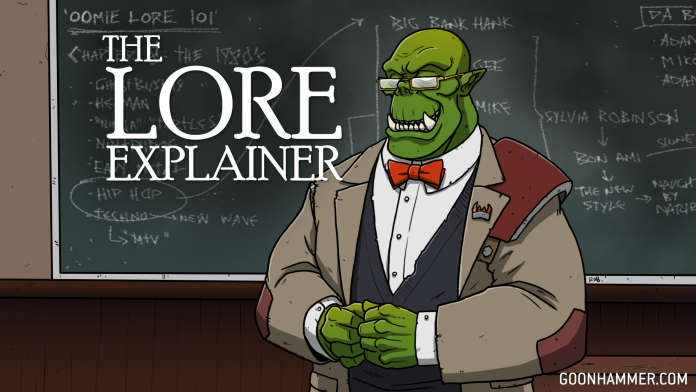In recent years, as the Age of Sigmar game has established itself, the lore behind it has evolved into a fascinating and intriguing narrative setting. While it does take Warhammer Fantasy Battles as a foundation the Age of Sigmar lore is no mere re-boot or re-hash of its predecessor. It’s a distinctive and unique fantasy reality in its own right – and it’s really rather good. The story so far is split into three epochs: The Age of Myth, the Age of Chaos, and the Age of Sigmar.
Welcome to the Age of Chaos.
The Age of Chaos
Just like the ages of real-life actual history (Stone, Copper, Bronze, Iron, Ice, etc.), the Age of Chaos doesn’t start in a single place or time. There are certainly defining moments, but the age is more of a period in which the ruinous powers are ascendant over many years, spreading out across the mortal realms. And by “the ruinous powers,” we’re talking about all things Chaos. These are traditionally personified by the four traditional Chaos gods – Khorne, Tzeentch, Nurgle, and Slaanesh, plus the Great Horned Rat (who ascended to become the pantheon’s fifth god), plus Archaeon the Everchosen, who destroyed the old world and is not a god but doesn’t feel the need to be one, either.
Chaos was very much still present during the Age of Myth despite the flourishing of civilisation and order, and the Chaos gods spent most of it biding their time, pawing greedily at the realms and looking for a way in like grubby children smudging their faces against a shop window. All they needed was to find some cracks large enough to exploit and develop a foothold. And that’s exactly what happens at the start of the Age of Chaos.
There’s a ton to cover in the Age of Chaos, happening across every realm, and it’s not always easy to find a strict chronology of events for this period. We’re told different stories in different battletomes and novels, often from different perspectives. So rather than hopping all over the place to try and tell the story from start to finish, we’ll just focus on one realm at a time and what happened there during the Age of Chaos.
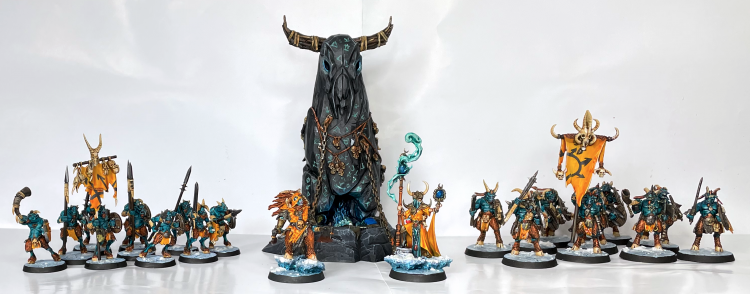
Ghur – realm of beasts
Beasts of Chaos have always been present in large numbers throughout the realms. In fact, before the Age of Myth was even a thing, the realms belonged to the beasts. For civilization to establish itself, the Beasts of Chaos had to first be subdued. But subdued didn’t mean “gone” and the beasts were still very much around, skulking in the shadows, and harrying civilization from the wings, staying a thorn in the side of the forces of order.
As the Age of Chaos dawns, the Beasts of Chaos become emboldened, starting to band together in ever larger herds. They are not a single, organized force with a plan, but they are nonetheless pivotal in ushering in Chaos, and in a form that is even purer than that which the iconic Chaos gods can offer. While there is a large Beasts of Chaos presence in every realm, their presence is perhaps most noticeable in Ghur, realm of beasts. Figures!
So Ghur is totally trashed during the Age of Chaos. Gorkamorka eventually breaks from Sigmar’s pantheon and leads his followers into a gigantic Waaagh! (all-out war) throughout the mortal realms. Ghur is especially affected by this, with the forces of Destruction rampaging through it like Keith Moon through a hotel room.
While the Beasts of Chaos and the forces of Destruction might share a lot of common ground – mainly in that they both want to see civilization obliterated – they disagree wildly about what the rubble should look like after that’s happened. Should it be a might-makes-right dog-eat-dog royal rumble, as preferred by the Destruction factions, or should it teem with chaos and mutation, as per the Beasts’ preferences? Either way the short-term solution is to fight over it. To the forces of destruction, and especially the orruks, the Age of Chaos is a gift from Gorkamorka. It is a time of constant strife, pain, destruction and violence, everything a healthy greenskin needs to grow up big and strong.
It’s also worth taking a moment here to mention the Skaven. Skaven are present in all realms, and also in the nooks and crannies between realms. They are, by far, the most numerous of peoples. Trillions of ratmen and ratwomen teem beneath the ground and in the inter-realm spaces, building enormous cities, such as Blight City, and experimenting with biological, genetic, arcane and technological warfare. Their might and their reach is truly unimaginable. As they sense the chaos energies growing, they begin to rise in power and ambition.
While all other Chaos forces are trying to make the best of their small numbers and slight opportunities, the Skaven are poised, ready to pounce in mind-boggling force and numbers. The dawning of the Age of Chaos is their chance! They have all the resources they need to utterly obliterate all resistance throughout the mortal realms and claim utter supremacy.
…But they have a massive civil war instead, focusing all of that indescribable might and power on destroying themselves, rather than the enemy. Classic Skaven.
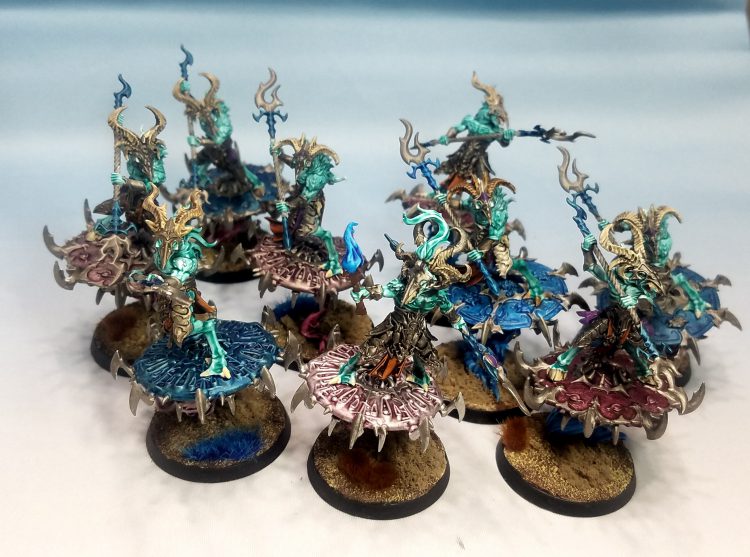
Chamon – realm of metal
It is in the realm of metal that the ruinous powers gain their strongest foothold.
Nowhere else is the material prosperity of the Age of Myth more apparent than Chamon. Technological advances, spurred on by the Duardin god Grungni, leads to more money, more luxury and, as is often the case in wealthy societies, more inequality. The rich grow richer as the poor grow poorer. The overlooked peoples of Chamon cry out and pray for change, and who should hear their prayer but the god of change himself, Tzeentch. This is the very opportunity the ruinous powers have been looking for.
Enter the Lode-Griffon. This huge god-creature appears out of nowhere and perches itself right in the middle of the realm of metal. It is so massive, and so powerful, that it begins to warp the fabric of reality around it, throwing the magic energies of the realm completely out of whack. Productivity grinds to a halt, businesses go bust and political power dynamics begin to shift. Further seeds of discontent are sown, further empowering the ruinous forces.
Many unsuccessful attempts are made to shift the Lode-Griffon until, eventually, a band of 9 aethermancers perform a not-very-subtle allegory about capitalism, by attempting a ritual that will turn the creature into gold. They are successful, to a degree, and the creature is killed, but at a greater cost than they are prepared for. Eight of the nine aethermancers are killed outright and a giant tear is torn in reality, through which legions of daemons begin to pour. The surviving sorcerer is revealed as one of Tzeench’s Gaunt Summoners; the ritual had been corrupted by chaos. Hell is unleashed, first upon Chamon and then quickly spreading to the other realms.
Chamon remains Teentch’s playground and is quickly overwhelmed. Chamon’s Grungni-worshipping Duardin take to the skies, using new and experimental technologies, forming huge flotillas and sky ports. Their god, Grungni, is nowhere to be seen, so the airborne Duardin conclude that all they have is each other, so put aside their squabbles and decide to work together. They sign The Code, a document which will outline their new cultural identity and culture. The now newly formed Kharadron Overlords retreat further into the stratosphere to sit out the spreading Age of Chaos beneath.
Grungni does nothing as his realm is overwhelmed with chaos.
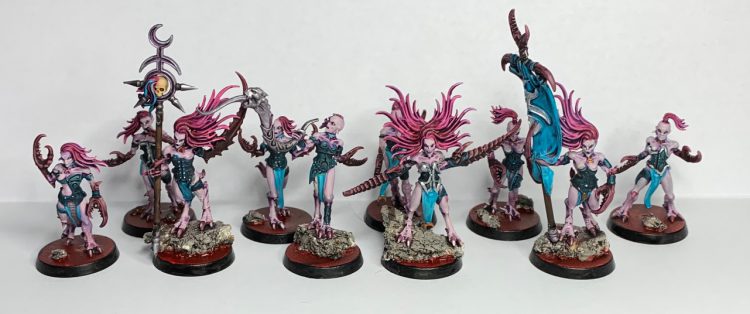
Ulgu – realm of shadows
While Tzeentch runs roughshod over the realm of metal, and Khorne and Nurgle find their own little realms to play with, and Slaanesh (chaos god of excess) mostly misses out on the Age of Chaos altogether. Instead, she remains bound in chains in Uhl-Gysh, the inter-realm space between Ulgu and Hysh. But Slaanesh’s followers are still active and taking cction.
Slaaneshi forces enter Ulgu, sensing that Malerion, god of shadows, probably has something to do with the disappearance of their god. The disciples of excess are, generally speaking, divided between those who want to find and restore their god, and those who want to make sure she’s gone for good and so that they can be the one to replace her.
But Malerion is having none of it and sees to it that the invading forces soon become disorientated and lost. Although the forces of Chaos make some progress into the realm of shadows, this progress is limited and Slaanesh remains trapped.
Hysh – realm of light
Teclis’ favourite children (the second batch of aelves he drew from Slaanesh, not the soulless ones who ran away from him to the bottom of the sea), have become a thriving society during the Age of Myth – wise, mystical and illuminated – but my gosh don’t they know it. Haughty and arrogant, drunk on the smell of their own farts, these ‘perfect’ aelves are totally destined for a fall. It doesn’t help that just next door, in the inter-realm of Uhl-Gysh, the chained-up Slaanesh is still able to whisper into the ears of aelven society unnoticed.
Driven by excess arrogance and entitlement, the aelves of Hysh eventually descend into war. This period, known as the Spirefall, sees these proud and spectacular aelven civilizations reduced to rubble. Arrogance leads to conflict, conflict leads to war, war leads to destruction, destruction leads to Chaos. As the aelven society smashes itself to pieces, Chaos wanders in, virtually unhampered, and takes the realm of light.
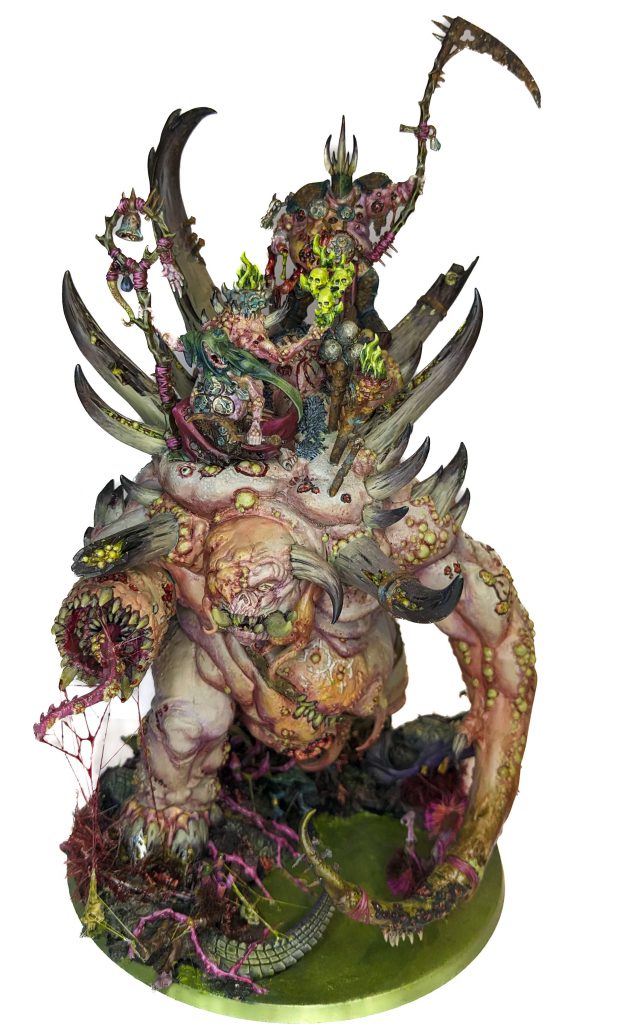
Ghyran – realm of life
Meanwhile, Nurgle, god of decay, sets his eyes upon Ghyran, realm of life. He is after all, in a manner of speaking, a god of life himself. He brings his own stinking and teeming take on life to the realm. As Nurgle’s garden flourishes throughout Ghyran, spreading rot and disease in the once green and pleasant land, Alarielle abandons Sigmar’s pantheon to focus all of her energies on defending her own realm, but eventually can do nothing but retreat from the plague god’s encroaching corruption. Nurgle’s champions hunt down the goddess, forcing her deeper into hiding. Ghyran becomes Nurgle’s.
With Alarielle gone, her aelven followers, who once lived so harmoniously with the Sylvaneth, cut and run, abandoning their homes and tree-like companions to try and seek shelter in Azyr with Sigmar – creating a deep sense of betrayal among their twiggy brethren that will never be forgiven.
Aqshy – realm of fire
As Grimnir found out the hard way, the fighting is good in Aqshy. It is no surprise, then, that Khorne, god of blood and war, takes a shining to the realm as somewhere he can bloody his followers. Khornite warbands march the realm of fire, each on their own path to glory to prove themselves, spilling blood and collecting skulls as they go.
Korgus Khol emerges as the undisputed conqueror of the realm, and the preeminent champion of Khorne. His army, The Goretide, is a colossal ocean of haemophile barbarians who view the realm as one giant all-you-can-eat buffet. Khul secures the realm of Aqshy for his lord, but all that killing and cannibalism can be stressful work, so Khul takes up a little craft project to unwind; he builds a colossal pyramid from a million skulls of his victims.
Also in Aqshy, large numbers of subterranean magmaholds house scores of Fyrslayers, worshippers of the dead god Grimnir. Although these udardin warriors can be found throughout other realms, Aqshy is probably the closest thing they have to a home.
The Fyerslayers fight bravely, repelling many Chaos armies. However, Chaos agents frequently infiltrate the refugees that the Fyerslayers take into their magmaholds so the doors are eventually closed, and the Fyerslayers sit out much of the Age of Chaos underground.
However, just as their estranged cousins, the Kharadron Overlords, thrive during the Age of Chaos, so the Fyerslayers also do very well out of the many mercenary contracts that desperate cities write up for protection. Payment is, of course, in ur-gold, which Fyerslayers believe contains the spirit of their shattered god.
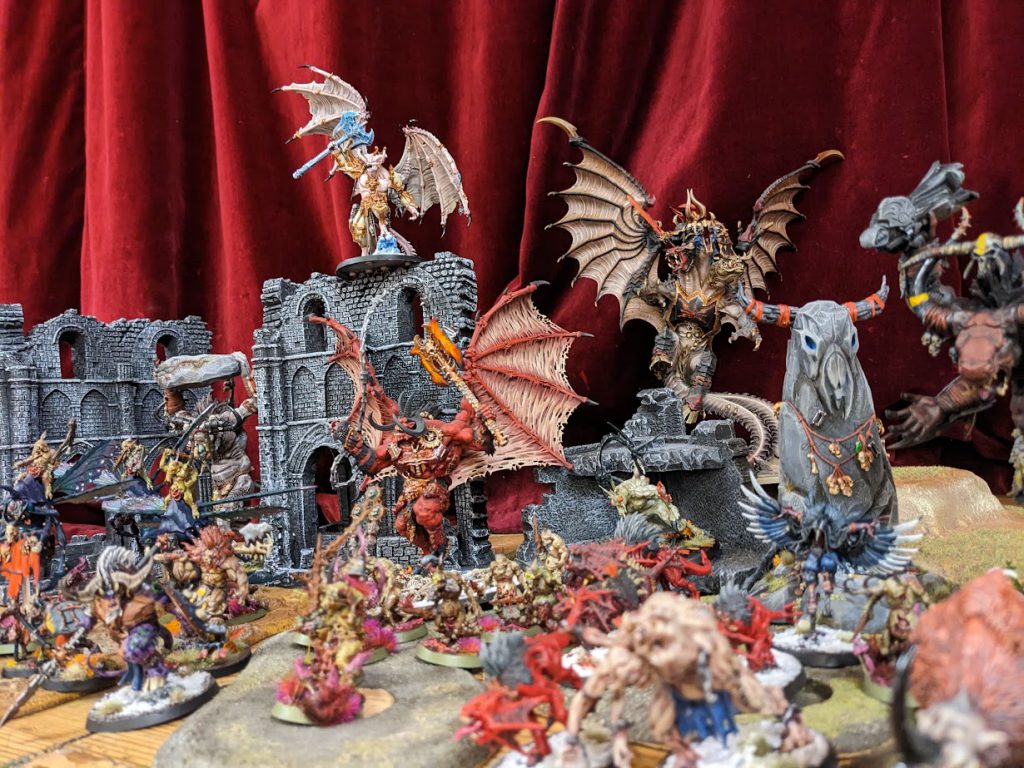
If it is possible to point to one moment that clearly marks the end of the Age of Myth and the beginning of the Age of Chaos, then it is the Battle of the Burning Skies, which takes place in Aqshy. Things are by no means going well for Sigmar’s pantheon at this point, but Chaos hasn’t won yet. Wherever Sigmar fights, the ruinous forces are driven back.
Archaon the Everchosen (of destroying-the-whole-world-and-everything-in-it fame) sees this and understands that if Sigmar were to be neutralized somehow, the forces of Chaos could go on to dominate everything. Unifying all of Chaos’ forces in a rare show of unity, Archaon leads an unstoppable army of daemons into the realm of fire.
Sigmar does his thing, and the pantheon is totally smashing it. Imagine Sigmar, Gorkamorka (this is before he goes off to do his own thing in the section above) and Teclis, all on the same side giving Chaos a proper beat-down. But Archaeon’s genius isn’t just martial, this guy knows his psychology, he knows Sigmar well, probably better than Sigmar knows himself.
Knowing how hot-headed and petulant Sigmar can be, Archaon reveals himself to the god-king, which instantly enrages Sigmar. There’s a lot of bad blood there. Sigmar hurls his war hammer, Gal Maraz, at Archaon. Only, it’s not Archaon, it’s a cheeky Tzeentchian trick, and the hammer gets sucked into the realm of chaos.
Without his trademark hammer, Sigmar’s power is compromised and his forces are driven back. The battle is lost, and the mortal realms are not far behind. Archaon sets himself up in the Allpoints, a kind of inter-dimensional porch where all realms meet, and there establishes his dominance over everything.
Shyish – realm of death
During the Age of Myth, we see Shyish largely brought under Nagash’s command. At this point, Nagash is a part of Club Sigmar. But only just. Nagash’s ambitions cannot be contained by Sigmar’s pantheon. As the Age of Chaos dawns, Nagash sees his opportunity.
As Archaon marches on the mortal realms and the Battle of the Burning sky commences, Sigmar sends out an invitation to all his pantheon and cordially requests the pleasure of their attendance at said battle. This is to be the battle that decides whether the forces of Chaos will ascend to dominance. Nagash replies that, with regrets, he is washing his hair that evening, and so cannot make it.
Nagash reasons that if he were to let Sigmar and Chaos beat each other to a pulp, one side would eventually destroy the other and the victorious side would emerge very much weakened. Not only that, the war would also produce lots of dead people, as wars do – meaning more soldiers for Nagash’s undead army. Nagash would then swoop in with his swollen ranks of the dead and crush all resistance to claim his place as supreme overlord.
The maths here are flawless. The problem is, Nagsh hasn’t counted on just how badly Sigmar would lose. So Nagash is now faced with a victorious and unstoppable Chaos army, and a really pissed off Sigmar. In response to Nagash’s betrayal, Sigmar begins a destructive rampage throughout Shyish.
During this rampage, Sigmar inadvertently releases Ushoran from the cage in which Nagash has kept him bound for centuries. Ushoran was a former favourite of Nagash who has been imprisoned in his torture chamber for decades, having slighted the god of undeath. Once beautiful and proud, Ushoran has now been forced to look at his transformed, hideous body for countless centuries, driving him utterly insane. His only coping mechanism is self-delusion, believing himself to be the fairest and most noblest of kings, and not the hideous cannibalistic-ghoul-vampire he has become. The delusion is so strong that everyone the newly-released (thanks, Sigmar) Ushoran comes into contract with gets sucked into the very same delusion, thus forming the Flesh Eater Courts.
Sigmar, however, does not find satisfaction. Nagash eludes him. Eventually his temper cools and he realizes he has abandoned his followers to the ravages of chaos. Sigmar decides to sound the retreat and call all his faithful to abandon the realms, and retreat to Azyr.
Nagash is now completely alone and without allies. In many ways, that’s what he wanted, only he was sort of hoping not to have any enemies, either. But there are plenty of enemies at his doorstep now as the forces of chaos turn their eyes on Shyish. Nurgle, having secured a foothold in the realm of life, now covets the realm of death. He’s a god of life and death, after all, held in perfect balance by decay, so it makes sense. But Khorne also likes the idea of claiming the realm of death and all its mighty warriors of old just waiting to rise back up and spill new blood.
So Chaos floods the realm of death, Nagash is killed, and everything he worked hard to build is razed to the ground. Nagash’s mortarchs retrieve his body and take it away to the under-underworld of Stygxx and wait out the Age of Chaos there.

Azyr – realm of heavens
All of the realms except Azyr, Sigmar’s own stomping grounds, are totally swarmed by darkness. It is an unstoppable tide, disease begets disease, despair begets despair, blood begets blood, corruption begets corruption, disillusionment begets disillusionment – the Chaos gods feed well, and only grow stronger and stronger.
Sigmar sounds the retreat and humans, aelves, duardin, and all who are loyal to Sigmar retreat to the realm of the heavens. The lucky ones arrive before the gates are shut, those who are not so fortunate are locked out to face their destiny alone. This breeds no small supply of resentment towards the god-king among those who are left behind who will, for generations to come, see Sigmar as an abandoner and betrayer.
Whilst Azyr is the most untouched of the realms, that’s not to say there is no ruinous presence there. Sigmar decides to purify his realm. This means the wholesale slaughter of anyone and everyone who looks like they might have been touched, or even tempted, by Chaos.
Having purged Azyr of everyone that doesn’t look right, Sigmar retreats from his people. He sits in front of that big lump of the old world he arrived on, and stares at it for, like, a really long time. Meanwhile, Chaos runs rampant over the other seven realms.
Why we can’t have nice things
It’s one of the questions that most fascinates human beings. Why do we mess everything up? Why does the guy with a beautiful, loving wife and perfect kids go out and have an affair that could jeopardise it all? Why do people vote against their own best interest in national elections? Why do we all make those silly mistakes that ruin a good thing? Why do fortunes disappear? Why do empires fall?
How did Chaos manage to get a foothold in the mortal realms when Sigmar’s pantheon, the most powerful beings in the realms, were united and everything was going so well? I’m not talking about the actual events that bought it about, but the principles and attitudes that allowed those events to happen.
Artists and philosophers have pondered this for as long as human pondering has been a thing. In Greek mythology we see Pandora’s curiosity and disobedience leading to evil entering the world. In Judeo-Christian theology, Adam and Eve, in their desire to become like God, eat from the tree of knowledge and open the way for evil and ruin to enter their perfect world.
There’s something within human nature to just always want more. We might have everything we need, but we still want more. You see that so wonderfully portrayed in the agendas and selfish desires of the Age of Sigmar gods, all of them pursuing their own gratification, each of them wanting more and more, which ends up costing them what they already have.
You can see the pattern repeated throughout history, as societies become wealthier and more decadent, they begin to decline and cannibalise themselves, leaving themselves open to hostile outside forces. Edward Gibbon, in the Decline and Fall of the Roman Empire wrote “There exists in human nature a strong propensity to depreciate the advantages, and to magnify the evils, of the present times.”
This is why we can’t have nice things.
Have any questions or feedback? Have a topic you’d like to see us cover in a future Lore Explainer? Drop us a note in the comments below or email us at contact@goonhammer.com. And if you want regular updates in your inbox, subscribe to our newsletter.
